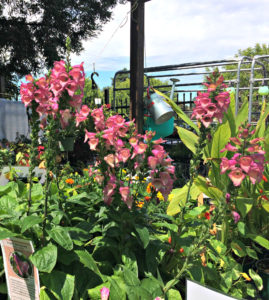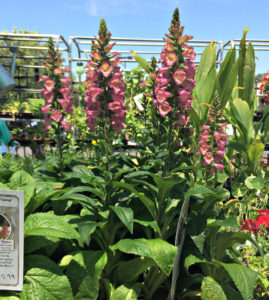Happy October! We love this time of the year in the garden, the mums are blooming, the pumpkins are ripe and the Foxglove is perfect for poisoning…Wait, what?
Yep, in honor of this month of horror, we will be talking about that ever-popular Victorian poison, Digitalis. AKA Foxglove.


What is Foxglove?
Foxglove is the common name for Digitalis. Digitalis is a genus of plants that is native to Europe, Central Asia, and Northern Africa. It is called digitalis because the flowers are perfectly shaped in such a way that you can put your fingers in them! For once we did not make that up, the whole genus of over 20 species is named after the fact that you can stick your fingers in them. (Side note, that though Digitalis has only been known as a medicine since the mid 1700’s it has long been known as a poison and as such is sometimes called “Witch’s Glove” which we like a lot and are going to change all the labels in the nursery when our boss isn’t looking)
You have probably seen Foxglove as we sell it in our nursery, and most people have a plant or two. It is a very popular plant.
Is it really poisonous?
Yes, it really is poisonous. It is very poisonous. We have to admit that our interest in botany began because we read too many Agatha Christie books as a child. Dame Christie loved using poison, and digitalis came up a few times (check it out here). However, she usually had the poisoner administer it by adding someone’s heart medicine to something as Digitalis, while being a poison to a normal heart, is actually medicinal.
Digitalis is used for Congestive heart failure and when your heart is beating too slowly. So like a lot of poisonous plants, it all depends on the context.
However, yes, your dog, child, rooster, husband can get sick and die if they decide to eat any part of the digitalis plant.
But before there is too much hue and cry, the same thing can be said for poppies, Rhubarb, Daffodils, and peaches (plus many more). The thing to remember with anything is to be aware of what is safe and what is not. For example Rhubarb and peach pie is amazingly delicious (and appropriate for this time of the year), but if you were to eat the leaves of the Rhubarb the Oxalic Acid in them would make you sick, and if you were to prepare the peach pit a certain way, you would produce a poison much worse than digitalis (no we won’t tell you more).
 Why do people grow it?
Why do people grow it?
Digitalis is a very pretty plant. It grows tall and produces the perfect (finger-shaped) flowers on the stalks in pretty bells formations. It adds great color above lower growing plants and is often used at the back of flower beds for height. It is also a good pollinator plant, and as before mentioned it is used medically to some degree. But really people grow it, for the same reason that they grow Belladonna, Oleander, Delphinium, Rhododendrons, Hydrangeas, and Lily of the Valley. These are beautiful plants, and because of their toxicity deer and most other garden vermin are not going to eat them.
How can I grow it?
 Foxgloves do well in well-drained loamy soil and prefer partial sun or shade. Some Foxglove originated along the Mediterranean and so is well adjusted to our climate here. You can start Foxglove from seeds. We prefer using seeds from local nurseries like Living Seed Company in Pt. Reyes as we know the seeds will be able to grow in our area. You can also but foxglove plants in 4” pots from our nursery. If you are unsure about whether your soil is suitable or not be sure to touch base with our Garden Guru Owen about whether or not you will need to feed the Foxglove plant.
Foxgloves do well in well-drained loamy soil and prefer partial sun or shade. Some Foxglove originated along the Mediterranean and so is well adjusted to our climate here. You can start Foxglove from seeds. We prefer using seeds from local nurseries like Living Seed Company in Pt. Reyes as we know the seeds will be able to grow in our area. You can also but foxglove plants in 4” pots from our nursery. If you are unsure about whether your soil is suitable or not be sure to touch base with our Garden Guru Owen about whether or not you will need to feed the Foxglove plant.
What if, I buy some and then someone knows I have it, and somehow figures out how to use it, and poisons someone, will I go to jail?
Look, we are bloggers, not criminal defense attorneys. You would have to ask one of them. However, we will give you this advice: If your friends are that sketchy maybe give planting poisons a pass, or you know get less scary friends.

